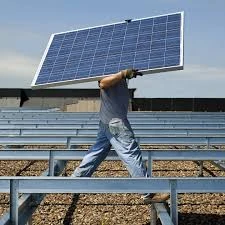solar panel efficiency high temperatures
The Impact of High Temperatures on Solar Panel Efficiency
Solar panels are a cornerstone of renewable energy, transforming sunlight into electricity. However, their performance can be significantly affected by environmental factors, with temperature being a critical element. Understanding how high temperatures influence solar panel efficiency is crucial for optimizing energy production, especially in regions that experience extreme heat.
Solar panels are typically designed to operate at a peak efficiency when sunlight hits them directly. However, as temperatures rise, the efficiency of solar panels can decline. Most solar cells are made from silicon, which has a negative temperature coefficient. This means that as the temperature increases, the voltage output of the solar cells decreases. Specifically, for every degree Celsius that the temperature rises above 25°C (77°F), the efficiency can drop by approximately 0.4% to 0.5%.
For instance, in extremely hot climates where daytime temperatures can soar above 40°C (104°F), solar panels may operate at a significantly reduced efficiency. This drop can lead to substantial losses in energy production for solar installations. It is important to note that while sunlight is the primary factor that drives energy generation, temperature management is equally critical for maximizing efficiency.
solar panel efficiency high temperatures

Heating issues are exacerbated by the design and installation of solar panels. Panels that are mounted flat on roofs can trap heat, further elevating their operating temperatures. In contrast, installations that allow for better air circulation can experience lower temperatures, thus maintaining higher efficiency levels. Therefore, careful consideration of installation techniques can mitigate some of the adverse effects of high temperatures.
Innovations in solar technology are also addressing the challenge of temperature-induced efficiency loss. Manufacturers are developing new materials and technologies that perform better under heat. For example, bifacial solar panels can capture sunlight from both sides, improving overall energy output even in less-than-ideal thermal conditions. Additionally, the use of solar panel cooling systems, such as integrated ventilation or liquid cooling technologies, is becoming more common. These systems can effectively reduce the operating temperature of solar panels, preserving their efficiency.
Moreover, understanding the local climate is vital for optimizing solar energy systems. Homeowners and businesses should consider the microclimates in their area when designing solar installations. Selecting panels specifically rated for high-temperature performance can also enhance long-term productivity.
In conclusion, while high temperatures can negatively impact solar panel efficiency, proactive strategies can help mitigate these effects. By employing better installation practices, utilizing advanced technologies, and understanding local climate conditions, stakeholders can maximize the energy output of solar installations. As the world shifts towards a more sustainable energy future, addressing the challenges of solar panel efficiency in high temperatures will be paramount for enhancing the viability of solar energy as a primary power source.
-
String Solar Inverter: The High-Efficiency Solution for Smart Solar EnergyNewsJul.14,2025
-
Revolutionizing Rooftop Energy with the Power of the Micro Solar InverterNewsJul.14,2025
-
Power Independence with Smart Off Grid Solar Inverter SolutionsNewsJul.14,2025
-
On Grid Solar Inverter: Powering the Future with Smart Grid IntegrationNewsJul.14,2025
-
Monocrystalline Solar Panels: High-Efficiency Power for the Future of Clean EnergyNewsJul.14,2025
-
Bifacial Solar Panel: A Smarter Investment for Next-Generation Energy SystemsNewsJul.14,2025







